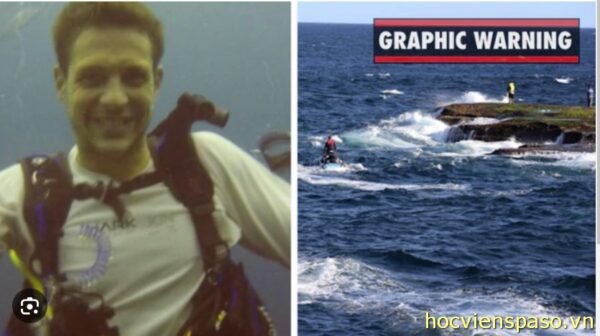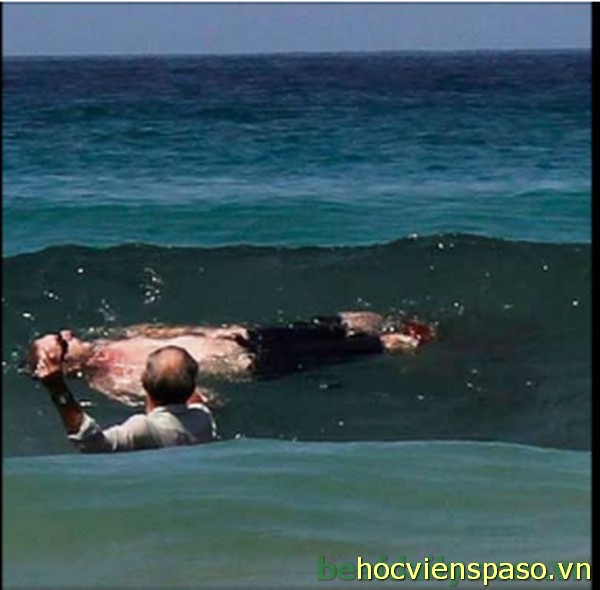Simon Nellist Video Reddit Viral: Tragedy Strikes
The heart-wrenching news of Simon Nellist’s life being claimed by a shark attack has cast a somber shadow over the coastal waters of Sydney. The incident, captured in the Simon Nellist video, occurred on February 16, 2022, off Little Bay, stirring emotions and igniting discussions on how to prevent such tragedies in the future. As the first fatal victim of a shark attack in Sydney after 60 years, Nellist’s untimely death has prompted the New South Wales government to seek solutions that prioritize both human safety and the preservation of the delicate marine ecosystem. In this exploration, we delve into the impact of the incident, current challenges, and potential measures to ensure safer coastal waters for all. For more details, follow hocvienspaso.vn!

I. What’s in Simon Nellist video?
On February 16, 2022, tragedy struck when Simon Nellist, a 35-year-old man, fell victim to a horrifying shark attack while swimming in the waters off Little Bay, Sydney. The incident, captured in the Simon Nellist video, sent shockwaves through the community and left many devastated by the loss of a beloved individual.

As news of the fatal shark attack spread, the public’s perception towards ocean activities in the region changed significantly. Fear and caution permeated the once-vibrant coastal areas, leading to concerns about the safety of locals and tourists alike.
In response to this tragic event, the New South Wales government swiftly pledged to review its existing policies and implement measures to minimize the risks of future shark attacks. Balancing the need for human safety with the preservation of marine life and the delicate ecosystem became a top priority.
The incident also brought renewed attention to the use of shark nets in certain areas to mitigate the risk of shark encounters. However, these nets faced opposition from animal activists who pointed out their adverse effects on marine life and the broader ecological impact.
II. Shark Attacks and Public Perception: Understanding Risks and Realities in Light of the Simon Nellist Video
Shark attacks have long captured the imagination and fears of the public, often leading to misconceptions about the behavior of these majestic creatures. Despite being relatively rare, when such incidents occur, they tend to have a profound impact on public perception and behavior around coastal waters.

One of the most common misconceptions is the belief that sharks actively hunt humans. In reality, shark attacks are typically accidental and result from mistaken identity. Sharks primarily feed on marine animals, and humans are not part of their natural diet. However, when a shark encounters a swimmer or surfer, it may mistake them for prey due to the visual and sensory similarities between humans and their typical prey.
The tragic incident involving Simon Nellist, captured in the Simon Nellist video, serves as a stark reminder of the potential risks associated with ocean activities. Such events can create a heightened sense of fear and apprehension among people who frequent the waters for recreational activities, impacting coastal communities.
However, it is essential to emphasize that shark attacks are statistically rare. The chances of encountering a shark in the water and experiencing an attack are minuscule compared to other risks in daily life. Understanding the true nature of these events can help dispel unnecessary fear and enable people to enjoy the beauty and recreational opportunities that the ocean provides.
Addressing public perception is crucial in fostering a healthy coexistence between humans and sharks in coastal areas. Education plays a pivotal role in this regard. Raising awareness about shark behavior, their critical role in maintaining the marine ecosystem, and safe practices for water activities can empower individuals to make informed decisions and reduce the likelihood of shark encounters.
By dispelling myths and providing accurate information, coastal communities can adopt a more balanced and respectful approach to sharing the waters with these remarkable creatures. While tragic incidents like Simon Nellist’s death serve as reminders of the potential risks, they also underscore the need for responsible and evidence-based strategies to ensure the safety of both humans and marine life in our oceans.
III. Challenges and Current Measures: Balancing Safety and Environmental Concerns in Light of the Simon Nellist Video
The incident involving Simon Nellist’s tragic death during a shark attack has highlighted the challenges faced in ensuring the safety of coastal waters while also considering the preservation of the marine ecosystem. As coastal areas in Sydney continue to attract tourists and water enthusiasts, addressing these challenges becomes increasingly important.

- Shark Nets and Environmental Concerns: One of the current measures in place to mitigate shark encounters is the use of shark nets in certain areas. These nets act as physical barriers to prevent sharks from swimming close to shore. However, shark nets have faced opposition from animal activists and environmentalists due to their impact on marine life. They can inadvertently catch and harm not only sharks but also other marine species, affecting the balance of the ocean ecosystem.
- Limitations of Shark Nets: Despite their installation, shark nets have proven to be imperfect deterrents. Some sharks can still swim under or around the nets, potentially leading to encounters with swimmers and surfers. Moreover, shark nets may create a false sense of security, leading individuals to venture further from shore, where they may face other risks.
- Public Awareness and Education: Educating the public about shark behavior and safety measures is crucial in reducing the likelihood of shark attacks. Raising awareness about the rarity of such incidents and dispelling myths can help people make informed decisions when engaging in water activities. However, ensuring that this information reaches all beachgoers can be a challenge.
- Balancing Human Safety and Marine Life Preservation: The primary challenge lies in finding solutions that protect human lives while also preserving the delicate marine ecosystem. Shark attacks are often a result of mistaken identity, and sharks play a crucial role in maintaining the balance of ocean life. Striking this balance is essential to ensure a sustainable and healthy coexistence between humans and marine creatures.
- Innovations and Alternative Solutions: To address these challenges, authorities are exploring innovative solutions, such as the use of drones equipped with thermal imaging cameras to monitor shark activity. Drones offer a less invasive alternative to traditional shark nets and can provide real-time data to respond swiftly to potential shark threats. However, the effectiveness and practicality of these technologies need to be carefully evaluated.
- Responsible Tourism and Ocean Activities: Encouraging responsible tourism and water-based activities can play a significant role in reducing the impact on marine life. Implementing guidelines and regulations for water enthusiasts can help minimize disturbances to sharks and other marine creatures.
In light of the Simon Nellist video and its impact on public perception, it is crucial to address these challenges proactively. By reevaluating current measures, embracing innovative and eco-friendly solutions, and fostering public awareness, coastal communities can strive to create a safer environment for both humans and marine life. Ensuring the long-term sustainability of our coastal waters is a collective responsibility that requires thoughtful consideration and collaboration.
IV. Conclusion
The tragic incident involving Simon Nellist’s untimely death during a shark attack has left a profound mark on the coastal communities of Sydney. The shockwaves of this unfortunate event have sparked crucial discussions on how to balance human safety with the preservation of the marine ecosystem. As we conclude this exploration, it becomes evident that addressing the challenges posed by shark encounters requires a thoughtful and holistic approach. The Simon Nellist video tragedy has urged us to reevaluate and strengthen our approach to coastal safety. By embracing innovative solutions, fostering public awareness, and promoting responsible tourism and ocean activities, we can create a safer environment for both humans and marine life.






